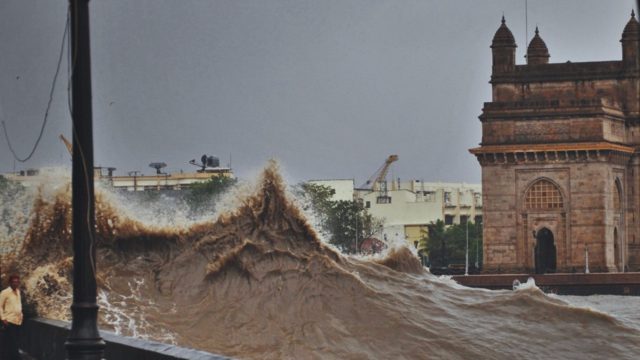What might happen if a Category 4 or 5 storm, with 240 kmph or higher wind speeds, were to run directly into Mumbai? Mumbai’s previous encounters with powerful cyclones occurred at a time when the city had considerably less than 1 million inhabitants; today it is the second-largest municipality in the world with a population of over 20 million.
Above image source: CNTraveller
In Mumbai, disaster planning seems to have been guided largely by concerns about events that occur with little or no warning, like earthquakes and deluges: evacuations usually follow rather than precede disasters of this kind.
With a cyclone, given a lead-up period of several days, it would not be logistically impossible to evacuate large parts of the city before the storm’s arrival: its rail and port facilities would certainly be able to move millions of people to safe locations on the mainland. But in order to succeed, such an evacuation would require years of planning and preparation; people in at-risk areas would also need to be educated about the dangers to which they might be exposed.
And that exactly is the rub—for in Mumbai, as in Miami and many other coastal cities, these are often the very areas in which expensive new construction projects are located.
Property values would almost certainly decline if residents were to be warned of possible risks—which is why builders and developers are sure to resist efforts to disseminate disaster-related information. One consequence of the last two decades of globalization is that real estate interests have acquired enormous power, not just in Mumbai but around the world; very few civic bodies, especially in the developing world, can hope to prevail against construction lobbies, even where it concerns public safety. The reality is that “growth” in many coastal cities around the world now depends on ensuring that a blind eye is turned towards risk.

Even with extensive planning and preparation, the evacuation of a vast city is a formidable task, and not only for logistical reasons. The experience of New Orleans in the days before Hurricane Katrina, or of New York before Sandy, or the city of Tacloban before Haiyan, tells us that despite the most dire warnings large numbers of people will stay behind; even mandatory evacuation orders will be disregarded by many.
In the case of a megacity like Mumbai, this means that hundreds of thousands, if not millions, will find themselves in harm’s way when a cyclone makes landfall. Many will, no doubt, assume that having dealt with the floods of the recent past they will also be able to ride out a storm.
But the impact of a Category 4 or 5 cyclone will be very different from anything that Mumbai has experienced in living memory. During the deluges of 2005 and 2015 rain fell heavily on some parts of the city and lightly on others: the northern suburbs bore the brunt of the rainfall in both cases. The effects of the flooding were also most powerfully felt in low-lying areas and by the residents of ground-level houses and apartments; people living at higher elevations, and on the upper storeys of tall buildings, were not as badly affected.
But the winds of a cyclone will spare neither low nor high; if anything, the blast will be felt most keenly by those at higher elevations. Many of Mumbai’s tall buildings have large glass windows; few, if any, are reinforced. In a cyclone, these exposed expanses of glass will have to withstand not just hurricane-strength winds but also flying debris. Many of the dwellings in Mumbai’s informal settlements have roofs made of metal sheets and corrugated iron; cyclone-force winds will turn these, and the thousands of billboards that encrust the city, into deadly projectiles, hurling them with great force at the glass-wrapped towers that soar above the city.
Continue reading at: QZ.com
Article source: QZ.com from Amitav Ghosh’s The Great Derangement: Climate Change And The Unthinkable. Buy the book here
Read similar article: South Mumbai at cyclone risk, Amitav Ghosh has reminded us









[…] Read more: What will happen to Mumbai if a cyclone rips through the city? […]